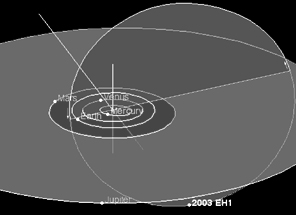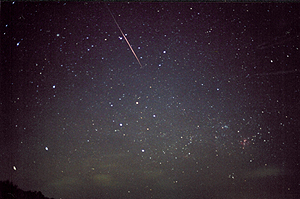|
Leonid MAC |
| home |
| View the shower |
| Mission Brief |
| Science Update |
| Media Brief |
| links |
LEONID DAILY NEWS: December 08, 2003

FIGURE 1. The orbit of 2003 EH1 is highly inclined at an angle of about 71 degrees and approaches the orbit of Jupiter at its furthest point from the Sun. QUADRANTID PARENT DISCOVERED
On December 08, the International Astronomical Union has issued a
telegram with the
announcement that the parent body of the Quadrantid meteor shower has been discovered in an orbit among the meteoroids. Peter Jenniskens is quoted as saying "2003 EH_1 (cf. MPEC 2003-E27) would seem to be a very strong
candidate for the parent of the Quadrantid meteoroid stream." The Quadrantids are named after the constellation Quadrans Muralis, a now defunct constellation on the borders of Ursa Major, Draco, Hercules and Bootes. This is our strongest meteor shower with Zenith Hourly Rates as high as 130 per hour. It is the only major shower without a parent body.
FIGURE 2: Quadrantid meteor near the constellation of the southern cross. Photo by Frankie Lucena, Puerto Rico. The Quadrantids are not visible from the soutern hemisphere. However, when you live in Puerto Rico, you can on occasion see a Quadrantid flash in the constellation of the southern cross. This rare photograph was obtained on January 4, 2003, byFrankie Lucena. In a paper submitted to The Astronomical Journal, Jenniskens explains how until this new discovery, the parent of the Quadrantid shower was thought to be lost from the stream. It was long known that the orbit of the Quadrantids evolves rapidly due to frequent close encounters with Jupiter. About 1,500-4,400 years ago, the orbit was only inclined by 13 degrees and the perihelion distance was only 0.10 AU. Now, the orbit is a steep 71 degrees and the perihelion distance has moved out to 0.78 AU. When comet 96P/Machholz 1 was discovered in 1985 in an intermediate orbit with a perihelion distance of q = 0.12 AU and an inclination of 60 degrees, it was long thought that this was the parent body. Peter Jenniskens identified the object, called 2003 EH1 (meaning the 33rd minor planet to be discovered in the first half of March 2003), among recent minor planet discoveries after searching for a parent with an orbit similar to that of the meteoroid stream. 2003 EH1 was first seen by the LONEOS "Lowell Observatory Near-Earth Object Survey" on March 06, 2003. The true nature of the object could only be reveiled after several other institutes followed up on these observations in the next 48 days and the preliminary orbit was updated. In a 1997 paper in Astronomy & Astrophysics, Jenniskens had predicted that such a body should exist, because photographic observations by members of the Dutch Meteor Society in 1995 had shown that the meteoroids move in nearly parallel paths moving to similar distances out into the solar system, to a point close to Jupiter's orbit. Each time when Jupiter approaches the stream, it will perturb some of the meteoroids, and as a result the shower disperses rapidly. The observed spread in orbital elements implied an age no older than about 500 years. The stream is very massive, however, about 10,000,000,000,000 kg. That is about 100-1000 times more mass than lost by a typical Jupiter-family comet in a single orbit. The young age of the stream only squares with that amount of mass if the meteoroid stream found its birth in the breakup of a comet about 500 years ago. Isihiro Hasegawa has pointed out that Chinese, Korean and Japanese observers recorded a bright comet in January of 1491 (C/1490 Y1) with an orbit similar to that of the Quadrantids. This is in fact in the right timeframe for this breakup to have occurred. Efforts to match the orbit of 2003 EH1 with the perihelion time of C/1490 Y1 in January 1491 have been unsuccessful to date due to the many close encounters with Jupiter that can greatly change the result of backward integrations for even very small changes in the initial orbit. Further observations are needed to establish this link. 2003: Dec 08 - Quadrantid parent discovered 2002: Nov 23 - "Shock" confirmed Nov 22 - New molecular band detected Nov 21 - Leonids tracked Nov 20 - Asteroids named after Leonid MAC participants Nov 19 - Leonid storms rich in faint meteors Oct 22 - Collecting meteoroid debris from snow cover Oct 21 - Highlights COSPAR/World Space Congress Aug 31 - First UV spectrum: Leonid from space 2001: Dec 11 - Shocking Leonid Dec 01 - Moon impacts Nov 26 - Near-IR persistent train emission Nov 24 - Results of near-real time flux measurements Nov 22 - Wowh! Optical meteor spectra 2000: Dec. 25 - Ursid shower circular IMO Dec. 24 - Ursid shows early release of sodium Dec. 23 - Ursid outburst confirmed Dec. 18 - Dec 22 Ursid outburst Nov. 20 - A bacterial fingerprint? Nov. 15 - HCN disappears mysteriously Nov. 14 - Meteor shower from space Nov. 13 - Organic fingerprint Nov. 12 - Train airglow chemistry Nov. 11 - Hard bits and persisting glows Nov. 10 - Meteoroid debris detected Nov. 09 - New meteor picture Nov. 08 - Spin city Nov. 07 - Meteors affect atmospheric chemistry Nov. 06 - Listen to this! Nov. 04 - Fear of heights? Nov. 03 - The pale (infra-red) dot Nov. 02 - Twin showers Nov. 01 - Leonids approaching Earth Oct. 31 - Prospects for Moon Impact Studies Oct. 30 - Comet dust crumbled less fine Today's news
| ||


